Pearls

“Pink Dream” from Empress Collection by Arpaia Fine Jewelry, designed by Kimberly Arpaia - freshwater cultured & seed pearl necklace

The Wedding Necklace designed by Kimberly Arpaia
Water’s Most Miraculous & Majestic Gems
Pearls might be the most-beloved gem of all time. Prized organic treasures from earth’s life-giving salt and fresh waters, pearls have embodied the mystery, power, and sustenance of Mother Nature throughout the centuries. Many historic cultures associated orb-like whitish pearls with the moon, and in ancient China, pearls were believed to guarantee protection against fire-breathing dragons.
Popular throughout European history, pearls symbolized modesty, chastity and purity. For centuries, rare natural pearls adorned only royalty and the powerful elite. Today, cultured pearls are available to a broad range of clientele throughout the world. Yet, their timeless beauty and elegance still reign supreme; perhaps, most sentimentally displayed by the traditional wedding gift from mother to daughter – a luxurious strand of cultured pearls to wear on that most special day, and ultimately, to pass down the generations.
Pearls are captivating with their alluring interplay of luminous luster, vast array of natural colors, and sometimes intriguing shapes. Pearl bodycolors (the basic color of the pearl) include every hue. Some pearls also have one or more color overtones, and a strong overtone can appear to modify or even dwarf bodycolor. And some pearls exhibit iridescence, known as “orient” in the trade, which most often occurs with irregularly-shaped pearls.
While saltwater pearls have a reputation for higher quality and value, some freshwater pearls are very high quality and very expensive. One of the most exciting pearl trends is the ever-expanding palettes of cultural freshwater pearl shapes and colors available in the marketplace. We are continually seeing freshwater crops with better overall quality, much as a result of China’s evolving cultured pearl farming techniques through research and experimentation. Someday, freshwater cultured pearls may rival the status of saltwater cultured pearls, and command similar high prices. Regardless of type, however, the value of any pearl should be based on merit and market demand, taking into account production costs, as well as the pearl’s quality, beauty, and rarity as a gem.
The realm of cultured pearls is tantalizing and a stunning tribute to the harmonious combination of science with nature.
How Pearls Form
Pearls Grow in Pearl-Bearing Mollusks
Natural and cultured freshwater and saltwater pearls form only in mollusks that produce a mother-of-pearl lining inside their shells. The same shimmery substance secreted by the mollusk that produces the shell lining also produces the pearl nacre.
In the 3 images below, the shells serve as beautiful backdrops for the cultured pearl jewelry. Although the cultured pearls did not grow in those particular shells, the images illustrate the magical results of the pearl-bearing mollusk’s iridescent fluid.
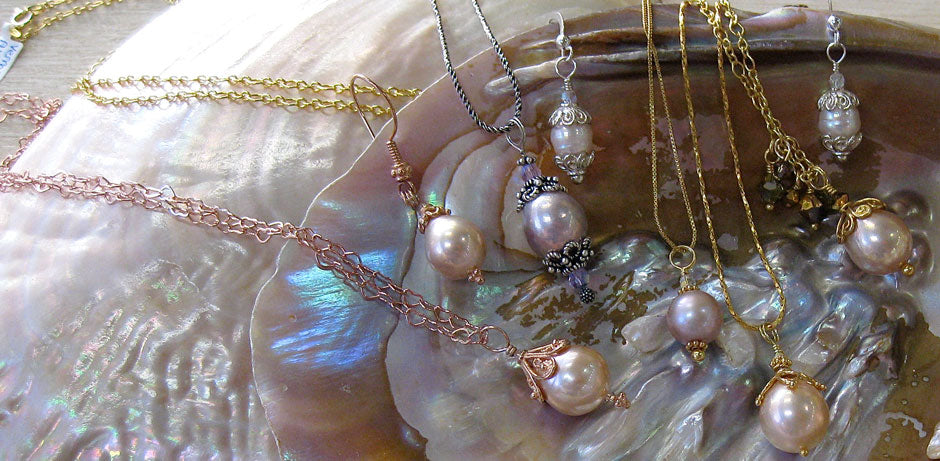 ABOVE: Arpaia cultured pearl drop pendants
ABOVE: Arpaia cultured pearl drop pendants 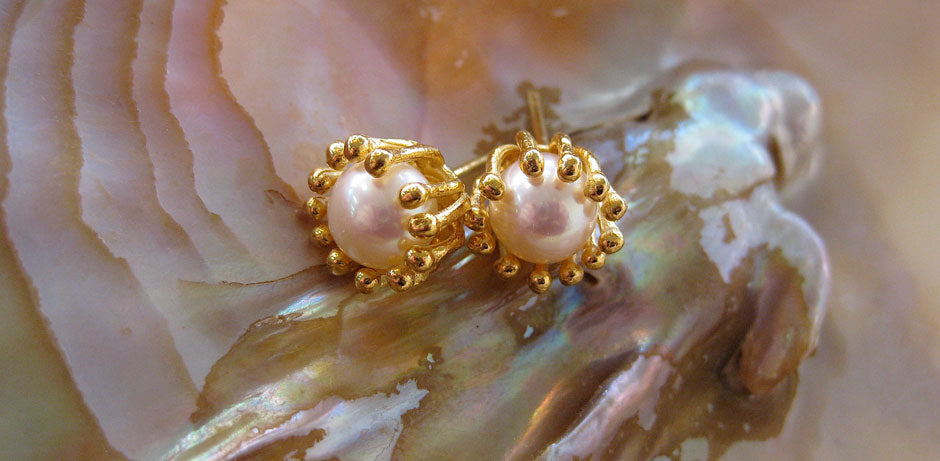 ABOVE: Arpaia “Coral Reef” cultured pearl earrings
ABOVE: Arpaia “Coral Reef” cultured pearl earrings  ABOVE: Arpaia Lang cultured pearl ring
ABOVE: Arpaia Lang cultured pearl ring
Natural Pearls
A natural pearl forms without human intervention, when a parasite or other microscopic foreign matter such as a sand particle enters the body of a pearl-producing mollusk. The mollusk deposits layers and layers of nacre over the intruder to soothe the irritation. Eventually the irritant is thickly coated and a lustrous pearl is formed. Natural pearls are rare, and virtually disappeared in the twentieth century due to pollution, over-fishing, and economic factors.
Cultured Pearls
Nearly all pearls sold today are cultured. Cultured pearls are real pearls, but they occur only by nucleation processes performed by skilled technicians. Today, most pearl-bearing mollusks are raised in hatcheries at the pearl farms specifically for culturing.
Saltwater Nucleation
Saltwater cultured pearls are bead and tissue nucleated. A mother-of-pearl bead, together with a piece of mantle tissue from a donor mollusk (oyster), is surgically implanted into the body of a living oyster.
The bead nucleus accounts for most of the volume and weight of the harvested cultured saltwater pearl. Due to the bead, saltwater cultured pearls are typically much larger than natural pearls. As long as the nacre coating is sufficiently thick over the entire bead nucleus, the saltwater cultured pearl should be gem quality possessing beauty and durability.
Freshwater Nucleation
Freshwater pearls can be bead and tissue nucleated, much like saltwater pearls. However, most freshwater mollusks (mussels) are nucleated with just a piece of harvested mantel tissue inserted into the living mussel. Since there is no bead nucleus with tissue-nucleated freshwater pearls, they are composed almost entirely of nacre.
After nucleation, workers watch over the mollusks while they recover from surgery – about 2 weeks – before they are transported to their protected new habitats, where they remain throughout the pearl-growth period. Workers carefully tend to the mollusks until the cultured pearls are ready to be harvested, including cleaning their outside shells and moving them for environmental reasons to ensure their good health and to assist nacre formation and quality, all which hopefully lends to a gem quality pearl.
Different growth periods apply to different types of pearls. South Sea cultured pearls usually grow inside mollusks for 18 to 30 months before harvested. The pearl-growth period for Tahitian cultured pearls is typically 16 to 24 months. Most akoya cultured pearls are harvested within 10 to 14 months, but some are harvested in as little as 6 months. Though freshwater cultured pearls can be harvested sooner, most tissue-nucleated freshwater pearls are allowed to grow inside the parent mussels for 3 to 7 years before harvested.
Types of Saltwater Pearls
Akoya Cultured Pearls
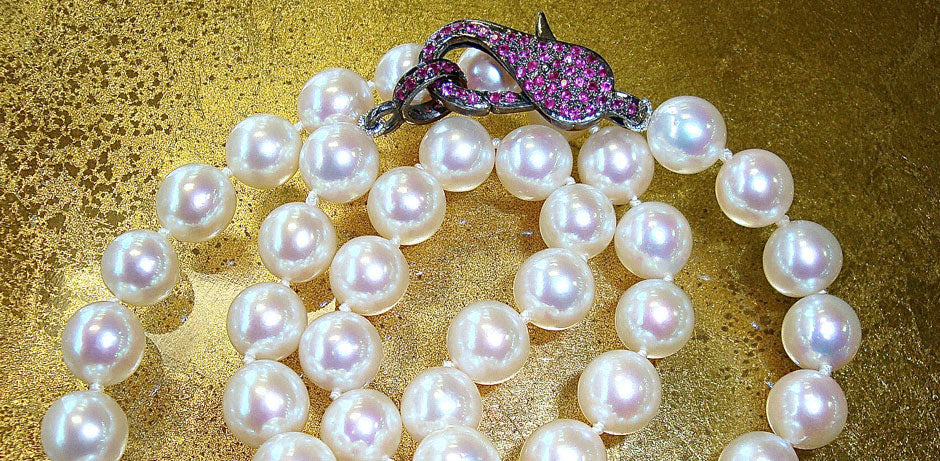 ABOVE: Arpaia Lang 8-8.5mm near-round Japanese akoya pearl necklace with handmade pink sapphire clasp
ABOVE: Arpaia Lang 8-8.5mm near-round Japanese akoya pearl necklace with handmade pink sapphire clasp
Akoya Pearl Oyster: Pinctada fucata martensii
There are several species of mollusks that produce akoya pearls, but the main akoya oyster is named the Pinctada fucata martensii. In the relatively cool Japanese seas, akoyas were the first pearl to be successfully cultured. While akoyas are abundant in Japanese waters, akoyas also grow in China, Korea, Southeast Asia, Australia, the Red Sea, the Mediterranean Sea, the Persian Gulf, the Caribbean Sea, and along the South and East African coasts.
Akoya Size Range: 2 mm - 11 mm Diameter
Akoya mollusks are smaller than other saltwater mollusks, and therefore, produce smaller cultured pearls than do South Sea or Tahitian mollusks. The typical size range of an akoya cultured pearl is 6-7 mm, but you might see them as small as 2 mm or as large as 11 mm in diameter.
Generally, all other value factors being equal, the value of an akoya pearl rises gradually with size. However, the increase is especially noticeable in the larger sizes. For example, there is an exceptionally large rise in value between 7-7.5 mm and 8mm akoya pearls, even though the size difference is only 0.5-1 mm.
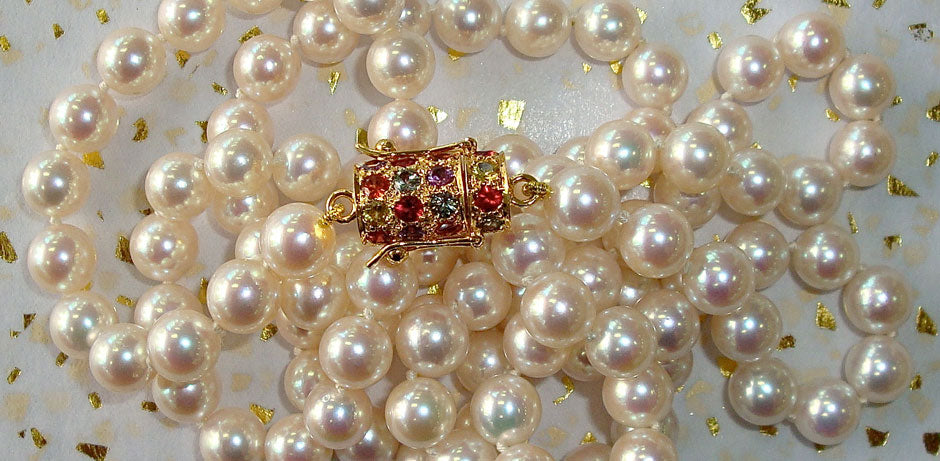 ABOVE: “Beyond” by Arpaia
ABOVE: “Beyond” by Arpaia 8-8.5mm round Japanese akoya cultured pearl double-strand necklace with handmade signature clasp in 18kt gold & natural multi-color sapphires
Akoya Shapes: Mostly Round and Near-Round
Most akoya pearls are round or near round (70-80%). Other akoya shapes include semi-baroque, baroque, and occasionally drops.
Akoya Colors: Mostly White and Cream
Akoya pearls typically have white to cream bodycolor, but other natural bodycolors include yellow, pink, gray and blue. Typical akoya overtones are pink or green.
Akoya Surface: Usually Glossy Luster and Good Surface
As the akoya grows through several seasons, the mollusk reacts to water temperature changes, and its caregivers adjust the position of the mollusks in different depths of water to account for temperature fluctuations. When seawater temperature casually drops, the akoya’s production of nacre slows, and the result is extraordinary luster quality. The best akoya cultured pearls possess an almost mirror-like smooth clean surface with reflective, deep, three-dimensional, glossy luster.
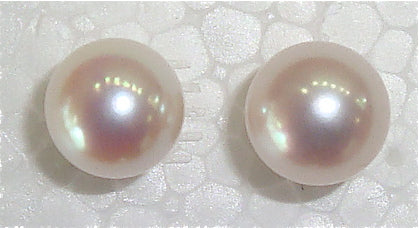
Arpaia Lang matched-pair Japanese akoya cultured pearls
Matched Akoya Strands
An excellent attribute of akoyas is their ability to be matched into pairs, strands, and jewelry sets. Their typical round shape, neutral bodycolor, smooth surface, and high luster, together with their abundance, allow them to be sorted into matched strands with relative ease in comparison to other cultured pearl types. Simple akoya cultured pearl strands and post-earrings are a fashion staple and bridal classic.
South Sea Cultured Pearls
South Sea cultured pearls are a true luxury - rare, expensive, and exceptional in every way.
High Production Costs
The principal South Sea commercial pearl farming areas are in Australia, Indonesia, the Philippines, and Myanmar (formerly Burma). The South Sea culturing process is an expensive and long undertaking rife with problems. South Sea oysters survive only in marine habitats. Caring for them in deep waters requires special and costly offshore equipment and methods. The pearl-growth period is typically 2 years. During that time, the oyster could die, or the pearl could be expelled or become misshapen. The high prices obtained for the best South Sea pearls are in direct relation to their rarity and the high cost to produce them.
The South Sea Pearl Oyster: Pinctada maxima
The host oyster of the South Sea cultured pearl is the Pinctada maxima. It is the largest oyster in the world at typically a foot circumference or larger, which accounts for the large size of the pearls that can grow inside their bodies.
South Sea Pearl Size: 8 mm – 20+ mm Diameter
The most defining characteristic of many South Sea cultured pearls is their large size, ranging from 8 mm to 20 mm or more, with the average size around 13 mm.
The Soft Luster and Glow of South Sea Cultured Pearls
In addition to their large size, South Sea cultured pearls typically have thick nacre and satiny luster that is quite unique compared to other pearl types that exhibit more of a metallic sheen. The luminous soft glow of South Sea pearls is especially appealing.
Round South Sea Cultured Pearls Are Rare
Only 10-30% of South Sea cultured pearls are round or near-round in shape. The more common shapes of South Sea cultured pearls are oval, button, drop, baroque, and semi-baroque.
South Sea Pearls Mostly Light Color
South Sea pearls come in a subtle array of colors, with most being light (white, cream, silver and pastel yellow). Deeper bodycolors are less common, and include yellow, orangey-yellow, and blue. Possible overtones are pink, green and blue.
The color of the South Sea mollusk’s mother-of-pearl lining along its outer rim is directly related to the South Sea pearl’s nacre color. Australia’s silver-lipped oyster produces mostly white, cream and silver South Sea cultured pearls.
Philippine’s golden-lipped oyster produces mostly yellow to orangey-yellow pearls, referred to in the trade as “gold” or “golden” South Sea cultured pearls.
Tahitian Cultured Pearls
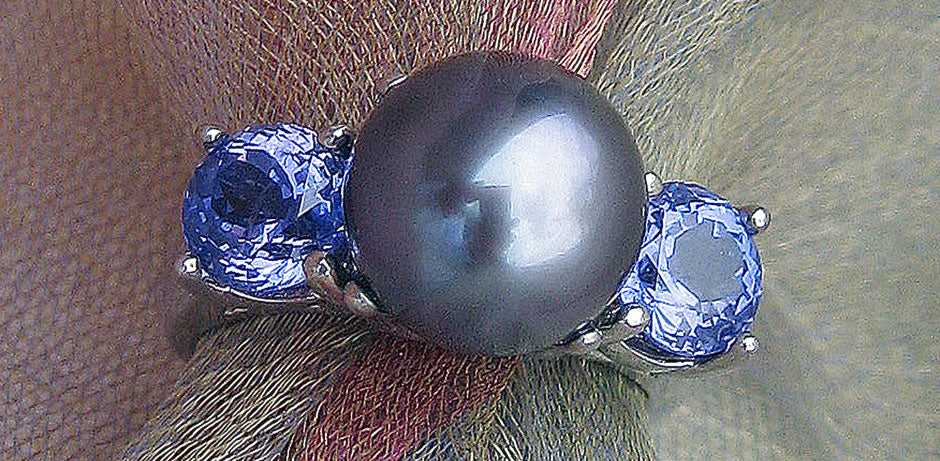 ABOVE: “Lavender Symphony” ring by Robert Lang - Tahitian cultured pearl with natural color brilliant cut sapphires
ABOVE: “Lavender Symphony” ring by Robert Lang - Tahitian cultured pearl with natural color brilliant cut sapphires
Tahitian Pearl Oyster: Pinctada margaritifera
The Tahitian mollusk is the rare black-lipped oyster known as Pinctada margaritifera cumingii. For centuries, the Tahitian mollusk was over-fished for it’s vivid dark mother-of-pearl shell. By the 1800s, many oyster beds had become endangered and nearly extinct. Successful Tahitian pearl culturing since the 1960s, however, has helped boost the Pinctada margaritifera mollusk population by raising them in protected sea farms.
Tahitian Pearl Farms Located Only in French Polynesia
Tahitian cultured pearls are farmed around the islands of French Polynesia, mainly in the atoll lagoons. An agency of the Tahitian government regulates and monitors the quality and quantity of cultured pearls that are exported from the country. The pearls must meet minimum standards of nacre thickness and nucleus coverage. Tahitian pearls are not treated in any way when processed after harvesting. They are certified to be of natural color and luster.
Tahitian Pearl Sizes and Shapes
About 40% of Tahitian cultured pearls are round or near-round. Other shapes include oval, button, drop, baroque and semi-baroque.
Tahitian cultured pearls measure between 9 and 14 mm diameter, with the most common diameter around 9.5 mm, and the most common range from 9 mm to 11 mm. Occasionally, a Tahitian cultured pearl will reach 16-18 mm.
Tahitian Pearl Exotic Colors
Tahitian pearls are best known for their exotic colors, most notably by descriptive trade names, such as “Peacock” (dark green-gray to blue-gray bodycolor with pink to purple overtones), “Aubergine” (dark grayish-purple bodycolor), and “Pistachio” (yellowish-green to greenish-yellow bodycolor).
The most common bodycolors of Tahitian cultured pearls are various shades of gray and black, with brown being less common.
Overtones of blue, green, purple, yellow, and/or pink can be so strong (below) that they obscure bodycolor and can be mistaken for it.
Tahitian Pearls: Shiny to Metallic Luster
Tahitian cultured pearls exhibit mostly shiny to metallic luster. There are a myriad of surface effects produced from the combination of color and luster, and when the exotic color of a Tahitian cultured pearl is united with metallic luster, the effects can be dazzling. Some pearls in the above image exhibit intense peacock colors paired with a coppery-bronze-like super-shiny luster. The pearls below exhibit cooler colors with a more chrome-like sheen.
Tahitian Pearl Surface
The surface of a Tahitian pearl can range from spotless (extremely rare) to heavily spotted (blemished). Most people will never see either of these extremes.
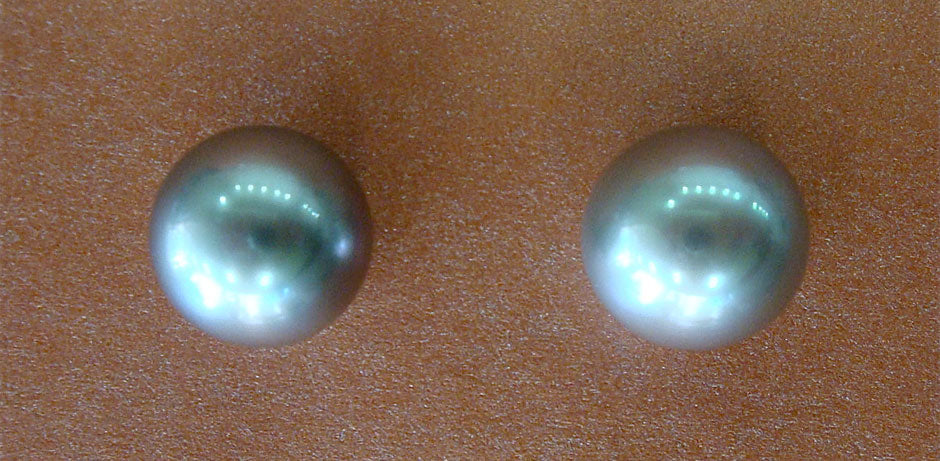 ABOVE: Arpaia matched-pair 14mm round spotless Tahitian pearls
ABOVE: Arpaia matched-pair 14mm round spotless Tahitian pearls
Cook Islands Cultured Pearls
The Cook Islands Pearl Oyster: Pinctada margaritifera
While the Pinctada margaritifera black-lipped mollusk produces Tahitian cultured pearls in French Polynesia, the same type of mollusk also is used to culture pearls in the Cook, Marshall and Fiji Islands, as well as in the Philippines. However, since these latter locations are outside of French Polynesia, cultured pearls from their waters cannot be called Tahitian Pearls - that name is reserved solely for pearls cultured in French Polynesia.
The Cook Islands span 695,000 square miles in Polynesia, but they are not French territories. Although they are associated with New Zealand, they are self-governed.
Cook Islands Cultured Pearl Attributes
Cook Islands cultured pearls come in many shapes. Spherical ones range in size from 8-15mm, with most between 9-13mm. The typical pearl-growth period is 18 months, and the nacre is usually thick at 1-1.5mm per radius.
Bodycolors of Cook Islands cultured pearls include black, gray, and brown, with blue to green, purple, yellowish-green, and pink overtones. Japan is the largest wholesale market for Cook Islands cultured pearls.
Sea of Cortez Cultured Pearls
The Sea of Cortez Pearl Oyster: Pteria sternia
A rare, naturally-dark pearl is cultured in the Sea of Cortez. Small quantities are harvested from nucleated rainbow-lipped Pteria sternia mollusks at a commercial pearl farm in Bacochibampo Bay near Guaymas, Sonora, Mexico.
The usual Sea of Cortez cultured pearl-growth period is 18-24 months. Like Tahitian cultured pearls, Sea of Cortez cultured pearls are not treated in any manner, except for rinsing with water to clean before sale.
It has been reported that the Pteria sternia mollusk’s future is uncertain and that their numbers have dropped. They are fragile mollusks and sensitive to the effects of catastrophic weather and global warming. Fishing boats also damage cages containing the nucleated mollusks. However, the pearl farm works to contain the harm, and crop yields are purposely kept small to maintain the rarity factor.
Attributes of Sea of Cortez Cultured Pearls
Sea of Cortez cultured pearls can exhibit vivid peacock colors with very strong orient (iridescence). Their natural bodycolors include silver-gray, brown, gold, and dark gray to almost black, with violet, pink, purple, gold, blue, green, and even red (“cranberry”) overtones.
Round and near-round shapes can range from 8-12mm, with most 8-9.5 mm in diameter. The luster of Sea of Cortez cultured pearls is silky, as opposed to the more metallic sheen of Tahitian cultured pearls, and their nacre is typically thick at 0.8-2 mm.
Freshwater Pearls

ABOVE: Empress by Arpaia – Sweet Summer Blush. 17" Necklace in Artisan 22 Karot Gold with Lustrous Freshwater Baroque Pearls
Small freshwater pearl crops are produced in Japan at Lake Biwa and Lake Kasumigaura.
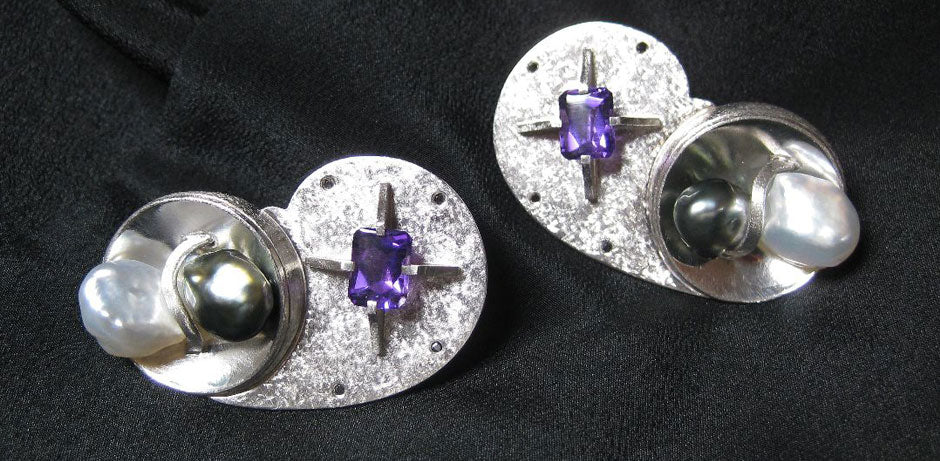 ABOVE: Palladium cufflinks by Robert Lang with natural white & black Biwa pearls, amethysts, and black diamonds
ABOVE: Palladium cufflinks by Robert Lang with natural white & black Biwa pearls, amethysts, and black diamonds
Freshwater pearls are also cultured in the United States at the Tennessee River Pearl Farm. Also, much of the mother-of-pearl bead nuclei used throughout the cultured pearl industry is produced in Tennessee and exported.
Attributes of Chinese Cultured Freshwater Pearls
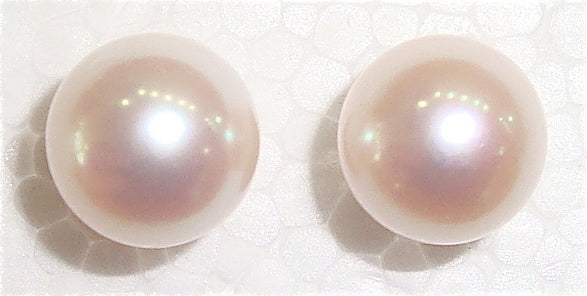
ABOVE: Arpaia Lang matched-pair 10mm round freshwater cultured pearls
Chinese freshwater cultured pearls are found in a wide range of sizes (4-14 mm), shapes, and natural colors. Bodycolors can be white, cream, yellow, orange, pink, or purple, and overtones can be pink, blue or green.
Only 2% are spherical (round and near-round), and only another 2% are symmetrical (oval and button shapes). Most cultured freshwater pearls are baroque and semi-baroque in shape, with the majority looking puffed rice.
Bead-nucleated freshwater pearls result in shapes that follow the contours of the bead, such as the coin-shaped bead-nucleated cultured freshwater pearls shown below.
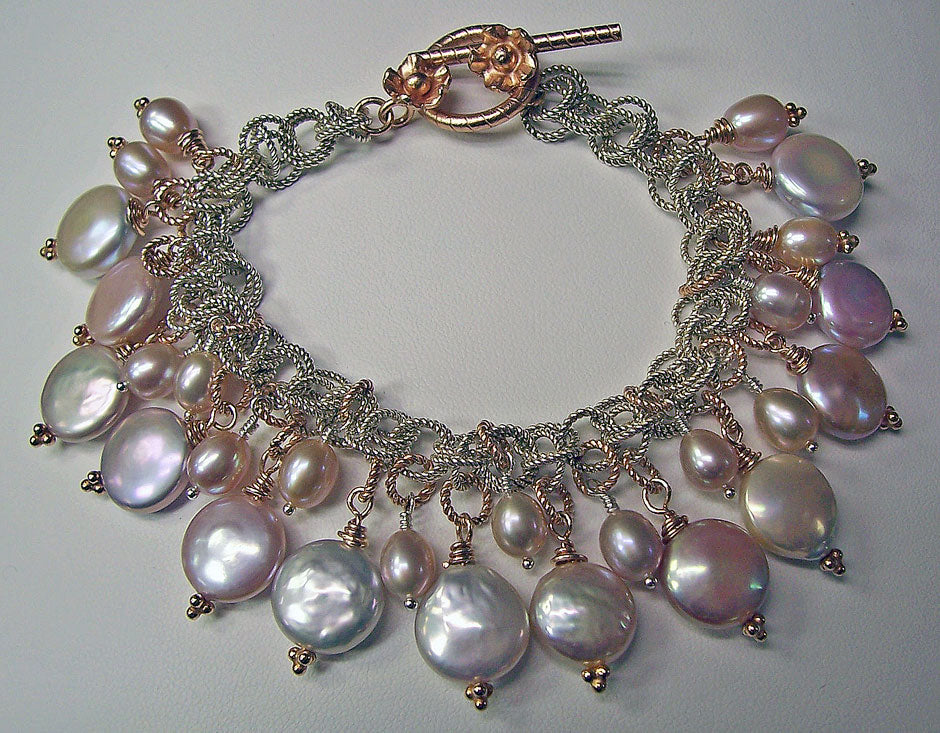 ABOVE: Arpaia cultured freshwater pearl handmade bracelet
ABOVE: Arpaia cultured freshwater pearl handmade bracelet 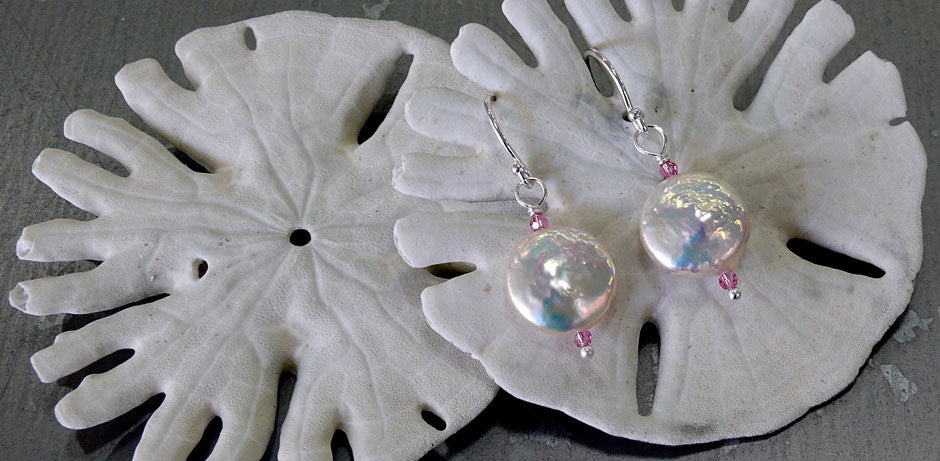 ABOVE: Arpaia cultured freshwater pearl earrings
ABOVE: Arpaia cultured freshwater pearl earrings
Great advances are being made in the Chinese pearl culturing industry. Improved harvesting and surgical nucleation procedures have achieved greater success with consecutive nucleations in a single mollusk. Longer growth periods inside the mussels are yielding bigger pearls, many with pleasing, plump shapes and extremely high luster.
Over the last decade, experimentation with different varieties of native mussels, as well as cross-breeding mussels at the hatcheries, have resulted in freshwater cultured pearls that display exotic natural colors with mirror-like luster.
Chinese technicians are aiming to produce a greater proportion of round and near-round pearls by these revolutionary bead-nucleation processes coupled with longer growth periods inside the mussel. It is predicted that eventually the process will become more refined and reliable. Ultimately, some Chinese freshwater pearls could rival the quality of saltwater cultured pearls and command their high prices as well.
Other Pearl Types
Keshi Pearls
 ABOVE: “Sorbet de la Mer” designed by Kimberly Arpaia
ABOVE: “Sorbet de la Mer” designed by Kimberly Arpaia South Sea keshi pearl & pink sapphire necklace
“Keshi,” the Japanese word for “poppy seed,” is the term used to describe the irregularly-shaped pearls that are accidental byproducts of saltwater and freshwater culturing processes. Keshi pearls are essentially all nacre and tend to be very lustrous.
Keshi pearls come in a variety of sizes, shapes and colors, and they occur in two ways: (1) Sometimes the nucleated mollusk expels the implanted bead nucleus, but retains the implanted mantle tissue, which stimulates nacre production and the creation of one or more keshi pearls; or, (2) Cells of the implanted mantle tissue become dislodged and stimulate the growth of separate keshi pearls around the cultured pearl.
 ABOVE: Arpaia Lang freshwater keshi pearl necklace
ABOVE: Arpaia Lang freshwater keshi pearl necklace
Blister Pearls
Blister pearls can form naturally, but most are cultured freshwater and saltwater pearls that grow attached to the inside shells of mollusks (rather than inside the mollusk’s body). In the culturing process, a half-spherical bead is affixed to the inside shell. Secreted nacre covers the bead, and when thick enough, the half-pearl is ready to be cut from the shell. The bottom side of the blister pearl is flat and without nacre.
Jewelry can be made with a blister pearl still intact to a portion of the surrounding shell in which it formed. If the blister pearl is cut entirely away from its surrounding shell, it is often made into a mabe pearl.
Mabe Pearls
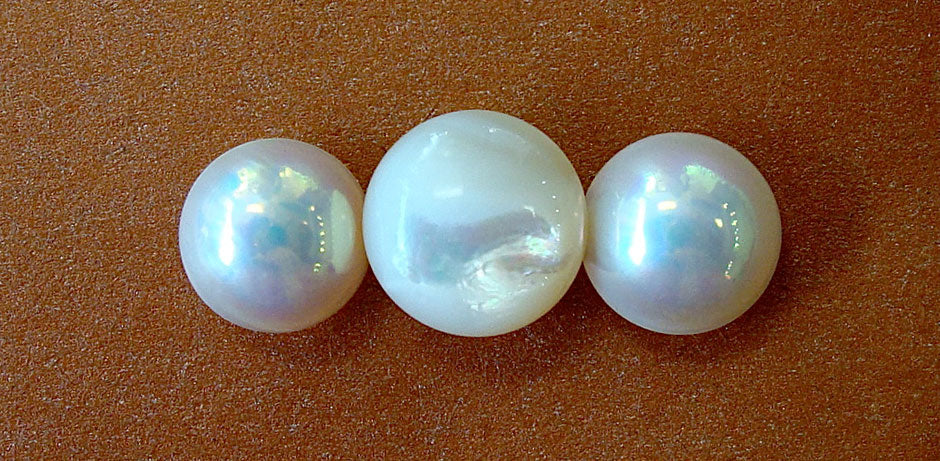 ABOVE: Arpaia - 3 akoya mabe pearls - the backside of the mabe pearl is 1mother-of-pearl (shown in middle). The half-round akoya cultured pearl forms the topside of the mabe pearl (shown above at left and right).
ABOVE: Arpaia - 3 akoya mabe pearls - the backside of the mabe pearl is 1mother-of-pearl (shown in middle). The half-round akoya cultured pearl forms the topside of the mabe pearl (shown above at left and right).
Mabe pearls are assembled cultured blister pearls. The pearl is cut from the shell and the bead nucleus removed. The void that is created by the removed bead is then filled with an epoxy resin or a new bead is inserted into its place. Finally, the half-pearl top is affixed to a mother-of-pearl back.
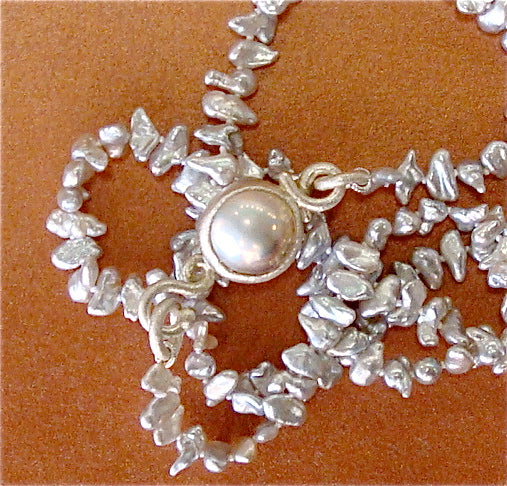
ABOVE: Arpaia Lang akoya keshi pearl necklace. The handmade fine silver clasp by Robert Lang incorporates an akoya mabe pearl.
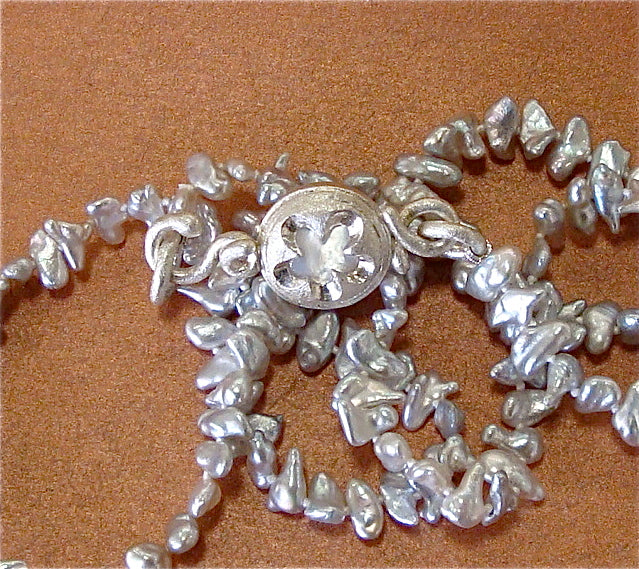
ABOVE: Arpaia Lang – the flower cut-out in the other side of the clasp shows the iridescent mother-of-pearl backing.
Grading Pearls at Arpaia
The GIA Pearl Description System
Traditional letter-grade systems are used throughout the world to denote the quality of cultured pearls. Gem-quality cultured pearls are often designated as A, AA, and AAA. There are many variations of the letter-grade system in use, and it seems that each purveyor has its own grading system. For example, sometimes distinctions are made within a single letter designation by also assigning numbers and/or symbols (A1, A2, A, A+).
Not all professionals assign similar grades even when using the same letter system. A single pearl or strand could be designated by one professional as A grade and by another professional as AA grade. The lack of a single standardized method for grading pearls and inherent subjectivity of current letter-grade systems yield inconsistencies in application.
Just like diamond grading before the diamond industry adopted the GIA diamond-grading system around the world, pearl grading is not standardized in the jewelry profession. To correct this deficiency, GIA has developed a pearl description system designed to be accurate and consistent when performed by experienced graders.
Arpaia is trained in using the GIA pearl description system to grade pearls, and we use it to buy, sell, and appraise pearls. There is a detailed, systematic, controlled approach to using the GIA pearl-grading system. For purposes of simplicity here, we merely list the 7 pearl value factors involved with using the GIA system.
GIA’s 7 Pearl Value Factors
(Determined Without Magnification)
SIZE
Pearl size is always stated in millimeters. Generally, all other factors being equal, the larger the pearl, the more valuable it is.
SHAPE
The shape of the pearl is identified as:
- Spherical (round or near-round)
- Symmetrical (oval, button, or drop)
- Baroque (semi-baroque or baroque)
Relating to all shapes, a possible Shape Modifier is:
Circled (pearl that has one or more grooved or ridged rings around the entire circumference of the pearl)
COLOR
Pearls come in a variety of natural colors. While the most common colors are actually neutral or near-neutral (white, gray, black, silver, cream and brown), the pearl palette includes many other colors.
Pearl color can have up to 3 characteristics:
All pearls have a Bodycolor. It is the dominant, overall color appearance of the pearl based on its hue, tone and saturation. If the pearl has an overtone, bodycolor is best seen at the outer rim of the pearl.
Some pearls do not have any overtone color, and some pearls have one or more color overtones. Overtone is a noticeable translucent color over the bodycolor.
Some pearls also may exhibit Orient (two or more translucent overtones or surface iridescence). Orient is usually seen with irregular surfaces, such as baroque shapes.
LUSTER
Luster is the intensity of light reflected from the pearl surface, rated as Poor, Fair, Good, Very Good, or Excellent.
SURFACE
Pearls commonly have blemishes or irregularities that are usually confined to the surface. The surface clarity of pearls is rated as Heavily Spotted, Moderately Spotted, Lightly Spotted or Clean. Completely spotless (blemish-free) pearls are extremely rare.
NACRE QUALITY
For consideration of a pearl as gem quality, it must have sufficient nacre thickness and coverage (layering). Nacre quality is rated as Acceptable. If nacre quality is not acceptable, the reason may be related to a Nucleus Visible (applies only to bead-nucleated cultured pearls – the pearl shows evidence of the bead nucleus through the nacre) or a Chalky Appearance (pearl has an obvious dull appearance).
MATCHING
Matching relates to the uniformity of pearls in a single piece of jewelry, such as a strand of pearls or a pair of earrings. The grader judges the consistency of size, shape, color, luster, surface quality, and nacre quality among the pearls. Matching is graded from Poor to Excellent.
Where pearls are intentionally mismatched, this value factor focuses on the degree of overall harmonious design and balanced effect.
Pearl Treatments
Cultured pearl manufacturing processes and treatments are designed to improve the appearance and value of pearls. They are often secretive techniques and not disclosed by the pearl farmers or processors (manufacturers). The lack of shared information in the pearl trade, combined with the non-detectible nature of some widespread treatments, can make it difficult or impossible to know precisely the enhancements, if any, made to a particular pearl or strand.
Unless we have specific knowledge to the contrary, Arpaia Lang assumes that all akoya and freshwater cultured pearls sold in the marketplace have been subjected to routine procedures during manufacturing, including cleaning, bleaching, buffing, tinting (akoyas), and maeshori treatments (also including South Sea).
Cleaning, Bleaching, and Buffing
Cleaning, bleaching and buffing are usually undetectable and are more often considered routine processes rather than treatments.
Cleaning
After harvesting, all pearls are cleaned to remove mollusk residue on the pearl. While some pearl types may be just rinsed with water, other pearls go through more rigorous cleaning methods.
Bleaching
Tahitian and South Sea pearls are rarely bleached in the manufacturing process.
However, virtually all akoya cultured pearls and the overwhelming majority of light-colored freshwater cultured pearls are bleached during the cleaning process to lighten dark spots and contribute to their uniform appearance.
Although bleaching cannot be detected, it is assumed to occur with respect to all akoyas and freshwater pearls because the technique is essentially uniformly adopted in the industry.
There is disagreement in the jewelry trade about whether bleaching is a treatment that must be disclosed or a process which does not require disclosure.
By traditional gemological standards, bleaching is a treatment because it fundamentally alters and improves the appearance and value of cultured pearls. However, because bleaching is widespread and longstanding (about 100 years), many in the industry regard bleaching as a process that does not require disclosure.
Buffing
Buffing is a standard procedure in the manufacturing of akoya and freshwater cultured pearls. It is done with or without a polishing compound and it removes minimal surface imperfections and also adds a polished appearance to pearls. Buffing must be performed carefully so that nacre is not damaged or stripped.
Although buffing improves the appearance and value of pearls, and therefore, logically would seem to be a treatment, the industry considers buffing a process that does not require disclosure.
Tinting Akoyas to Produce Very Light Pink Bodycolor or Rose Overtones
Tinting is achieved by soaking akoyas in a weak solution of red dye. Referred to as “pinking” in the trade, the tinting of akoya cultured pearls originated in Japan.
Pinking was applied to high quality akoya cultured pearls to enhance their rose overtones. Pinking became a common practice after WWII with the resurgence of the cultured pearl industry, when post-war customers mainly in the United States preferred very light pink pearls to white.
Chinese akoya processors – some with Japanese participation - adopted Japan’s pinking technique, and the pinking of akoya pearls is now an industry-wide practice.
Like bleaching, most trade organizations and many government agencies consider pinking a treatment that must be disclosed, while some in the pearl trade say it’s a routine process that does not require disclosure.
Maeshori Techniques to Enhance Luster
A treatment called “maeshori” originally began in Japan with the cleaning of akoya cultured pearls in a methyl alcohol solvent to remove impurities prior to bleaching. The procedure has expanded to involve several other treatments that are now also applied to most freshwater cultured pearls and some South Sea cultured pearls.
Although all pearl values are important, luster is of primary importance. A pearl can excel in all other value factors, but if it does not have good luster, its worth is devalued. As a result, many secretive techniques have been developed to enhance pearl luster, thereby increasing marketability of the pearl harvest.
Some maeshori treatments enhance luster with a variety of solutions designed to swell the nacre platelets to create a smoother surface with more light reflection. None of the current luster treatments are known to be permanent. The enhanced luster fades over time. Luster-enhancing maeshori treatments are applied to some freshwater cultured pearls in China, some akoya cultured pearls in Japan and China, and some South Sea cultured pearls in Australia and elsewhere.
Dyeing to Change Color
After cleaning, some pearls are dyed to change bodycolor. While most dyes are stable, some colors may fade.
Dyeing is a common pearl treatment and is usually detectible by a trained gemologist or gem lab. With high magnification, it is sometimes possible to see dye concentrations at the drill holes or in surface blemishes on the pearl. Strong dye concentrations often can be seen with the naked eye and might even rub off on the stringing material.
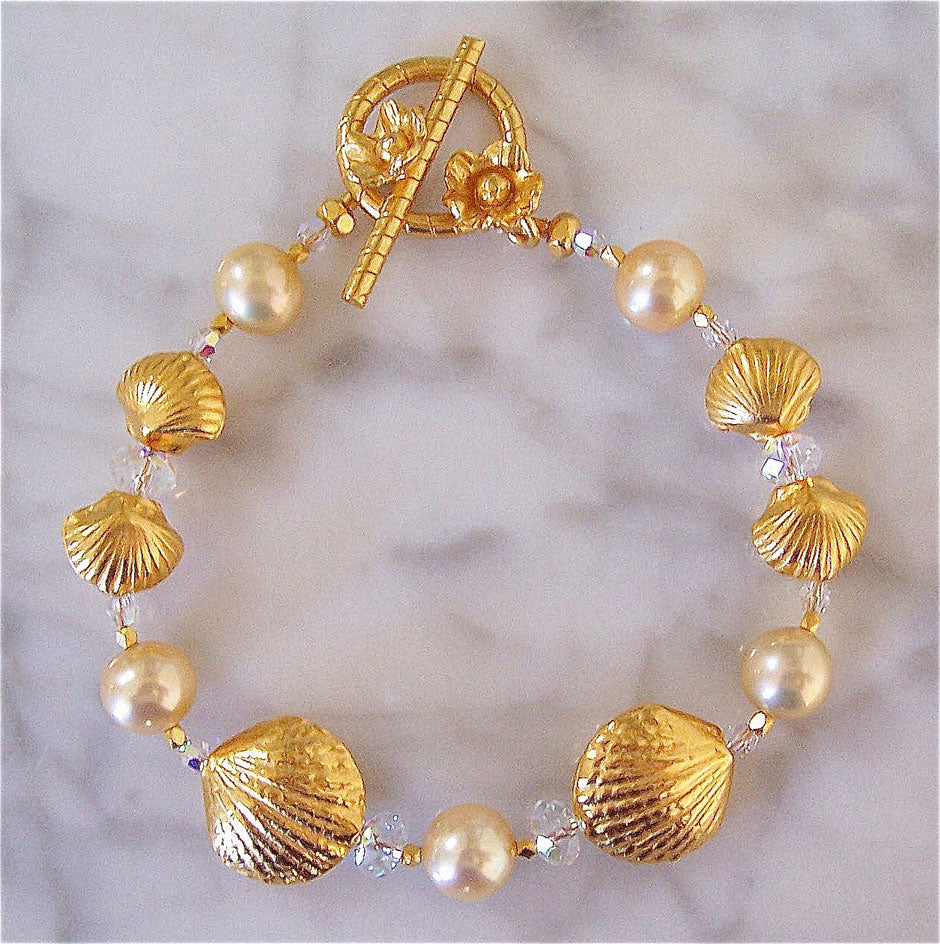

ABOVE TWO IMAGES: Bracelet & necklace by Arpaia Fine Jewelry with dyed cultured freshwater pearls. The color is called “maize.” It is intended to simulate the natural golden color of South Sea pearls.
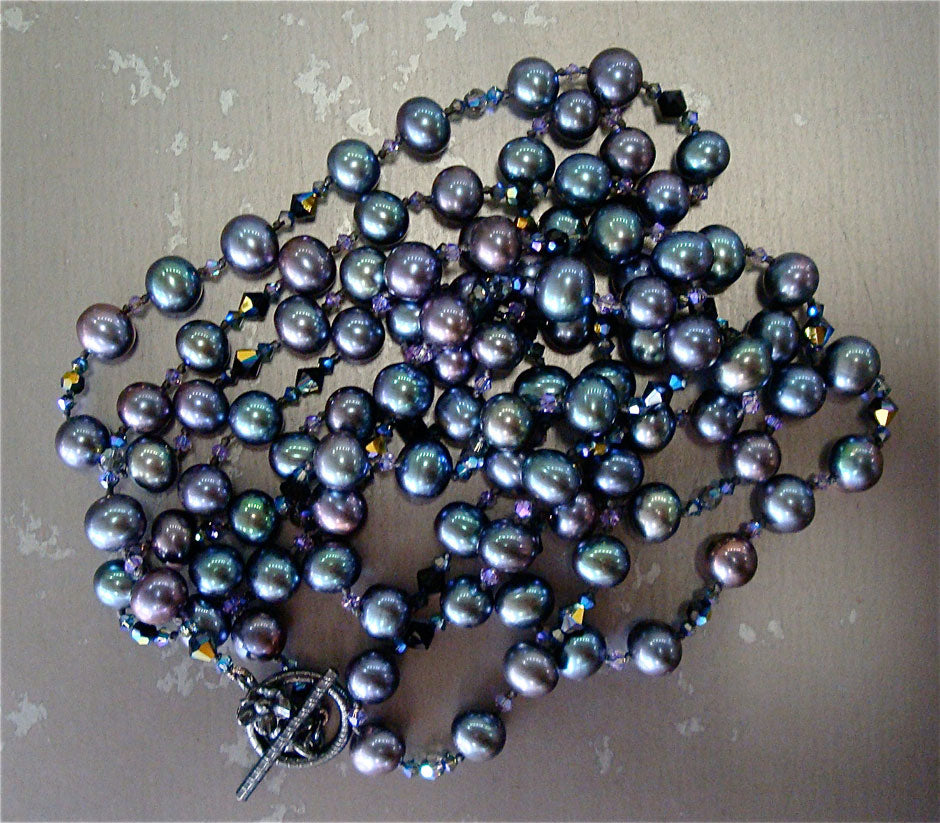
ABOVE: Arpaia Lang necklace with dyed cultured freshwater pearls. The dyed “peacock” colors simulate natural Tahitian pearl colors.
Irradiation to Change Bodycolor
Occasionally, pearls are irradiated to permanently produce black, gray, or blue-gray bodycolor in a white or cream-colored pearl. Sometimes irradiation is a detectible treatment, but more often it requires advanced testing by a gem lab to detect.
Coating to Enhance Appearance
Coatings enhance pearl luster and are usually used on lower quality pearls. This treatment might not be permanent as coatings can wear or be damaged. Coatings typically feel smooth and are often unevenly deposited in surface depressions.
Pearl Stats
Pearl Hardness
Pearls are an organic gem and are very soft. They scratch and abrade easily. As a result, pearls rate only a 2.5-4.5 on the Mohs hardness scale.
Pearl Toughness
Pearls typically have good enough toughness to be worn as a gemstone in jewelry. However, their toughness can be compromised due to lack of sufficient pearl nacre, excessive bleaching during processing, aging, and dehydration by environmental conditions such as improper storage or nearness to heat.
Pearl Stability
Due to the soft organic nature of pearls, they can be damaged from heat, light and chemicals. While most pearls are stable in light, heat from intense light can cause dehydration leading to cracked nacre. High heat can burn pearls or cause discoloration, splitting or cracking.
Many chemicals and cleaning agents harm pearls, and all acids, including hair spray, perfume, cosmetics and even acid perspiration, will damage nacre.
Pearl Care
Recommended Cleaning of Pearl Jewelry
For routine at-home care, pearls should be wiped after each wearing with a very soft, clean damp cloth.
If a thorough cleaning is needed, pearls occasionally may be washed gently in warm soapy water using mild soap (not a detergent) and a very soft cloth. Lay washed pearls on a clean towel to dry, and make sure strung pearls are completely dry before wearing.
Never clean pearls in an ultrasonic or steam cleaner.
Recommended Care of Pearl Jewelry
- Periodically restring pearl strands as needed. Silk string should be clean and knots should be tight with no slack between pearls.
- Pearl jewelry should be last item on and first to take off.
- Make sure to remove pearl jewelry before applying cosmetics, perfume, lotions and hairspray.
- Do not wear pearls while swimming in a pool - chlorine can damage them.
- Do not to wear pearls while washing dishes, doing housework, gardening, exercising, during strenuous work, or working with chemicals.
Imitation, Faux, Man-Made Pearls
The terms “faux pearls,” “imitation pearls,” “handcrafted pearls,” and “man-made pearls” all mean that they are not real pearls. They are simulants designed to look like natural or cultured saltwater or freshwater pearls. For purposes here, we use the term “imitation pearls.” Basically, imitation pearls are man-made beads manufactured entirely or mostly from inorganic materials. Imitation pearls are typically mass-produced beads in glass or plastic, though sometimes imitation pearls are made from reconstituted shell (called “shell pearls”). Then, the beads are often coated with various products to mimic the appearance of real pearls, and lastly sealed with a protective lacquer to make the finish more durable.
The Mediterranean island of Majorca, a region of Spain, is a major center of imitation pearl production. Majorica 1890 creates high quality pearl imitations that are more convincing than lower-quality, less expensive brands. Part of the allure of Majorica imitation pearls is their attractive gleam. An iridescent material called “essence d’ orient” (made with guanine, an organic crystalline substance found in fish scales) is coated in several layers over lead-glass beads.
Imitation Pearls Are Not Real Pearls
Imitation pearls are not pearls – they are not real. Although the term “imitation pearls” has received common usage, and apparently at least some acquiescence by the pearl profession, to avoid consumer confusion, we think the best practice is to omit the word “pearls” from all branding and description of pearl simulants. The term “beads” is more accurate. In addition, use of the word “organic” in connection with a pearl simulant is misleading where the majority of materials used to create the bead are inorganic by weight or volume.
Easy Tests to Determine Real Pearls from Imitation Pearls
There are several tests that can help determine if a pearl is fake or real:
General Appearance
Are the “pearls” even in color, tone, shape, size and luster? If yes, they are probably fake.
Imitation pearls do not have the physical composition of real pearls, nor do they share any of the same optical properties of natural and cultured pearls, and these differences often can be easily recognized by the naked eye. Your first impression that something does not appear quite right is probably a good indicator that the pearls are not real.
Fake pearls are nearly identical to one another. They reflect light in exactly the same way, and their colors are one-dimensional. Fake pearls are extremely even in color, tone, shape, and luster, and this is particularly evident when a single type of imitation pearl composes an entire strand.
Such evenness would be extremely rare, if not impossible, for cultured and natural pearls even in a well-matched strand. At a minimum, subtle differences exist from pearl to pearl.
As an organic real gem, no two pearls are precisely identical. Real pearls possess multi-dimensional surface and optical properties that result in depths of tone and color, as well as illuminating variances in luster, size and shape, even if those differences appear miniscule.
For example, the below images show jewelry made with akoya cultured pearls. Despite the excellent matching of pearls in these pieces, you can discern differences between the pearls with just a quick glance. Magnification would reveal even more variances.

ABOVE: Arpaia Lang “Snow Flowers” cultured pearl & diamond platinum earrings

ABOVE: "Lovely" cultured akoya pearl necklace from Empress Collection by Arpaia Fine Jewelry
When a customer comes into the shop to ask if a strand of pearls is fake, we do a fun exercise. We drape one of our cultured pearl strands next to theirs. Jaws drop - the visual differences between real pearls and imitation pearls become shockingly apparent.
Another visual cue that a pearl is not real is if it has a big hole. Real pearls are drilled with care to maintain their value and so they have precise thin drill holes. Fake pearls have big holes as a result of the manufacturing process, and the holes often are rimmed with coating substances. Fake pearls accommodate thicker stringing materials than real pearls.
Tooth Test
The Tooth Test is one of the most familiar tests used to detect fake pearls. Rub the pearls lightly along the biting edge of your upper front teeth. If they feel slightly rough, sandy or gritty, it is likely that they are cultured or natural pearls due to the layers of nacre that have formed over time. They are probably fake if they feel smooth or glassy.
However, the tooth test is not always conclusive. Sometimes real pearls are coated as an enhancement and may feel smooth. Conversely, manufacturers devise way to make fake pearls appear more real, and purposely roughen the outer surface to mimic the gritty texture of real pearls, thereby foiling the tooth test.
Magnification Test
Look at the pearls through an ordinary magnifying glass. A real pearl may have a clean surface, but it still does not appear even in the way that a fake pearl does. Most cultured pearls have some irregularities (ridges, bumps, creases, pits) sometimes referred to as “mother nature’s marks.”
Imitation pearls look smooth and even when compared to cultured and natural pearls. The surface of imitation pearls also may show seams, swirled structure, or gas bubbles.
Weight Test
Real pearls have heft when held in the hand. They tend to feel heavier than fake pearls. Imitation pearls made from coated resin or plastic are easy to detect because they are lighter in weight than real pearls. Solid glass beads, however, are heavier than real pearls, so the weight test is not always conclusive.


